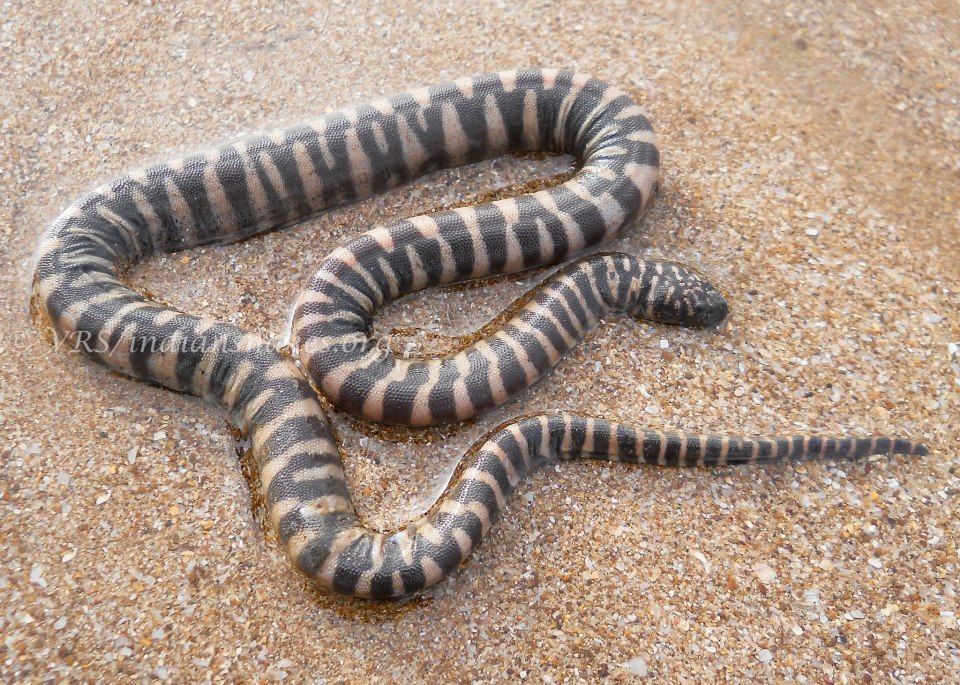| Citation |
|
Description |
Geographic Range [top]
Range Description: This species is known from peninsular India (northwest coast including Gujarat), Sri Lanka (Anslem de Silva pers. comm. 2009), Myanmar, the Nicobar and Andaman Islands (Chandi 2006, de Rooj 1917, Smith 1941), Thailand, Cambodia, Vietnam, China, the Philippines, Malaysia, Papua New Guinea, the Solomon Islands (Ehmann 1992), and coastal northern Australia (K. Sanders pers. comm. 2008).
Countries occurrence:
Native:
Australia; Bangladesh; Cambodia; China; India (Andaman Is., Nicobar Is.); Indonesia; Malaysia; Myanmar; Papua New Guinea; Philippines; Singapore; Solomon Islands; Sri Lanka; Thailand; Vanuatu; Viet Nam
FAO Marine Fishing Areas:
Native:
Indian Ocean – western; Indian Ocean – eastern; Pacific – northwest; Pacific – western central
Lower depth limit (metres): 20
Range Map: Click here to open the map viewer and explore range.
Population [top]
Population: This species is common throughout its range, extremely common in some places (A. de Silva pers. comm. 2010). It is frequently observed in the nearshore areas of the Indian sub-continent and its backwaters (A. Lobo pers. comm. 2009). It was found to be relatively common in trawler bycatch in western Malaysia in 1989 (Stuebing and Voris 1990). The global population status is unknown but most likely to be stable.
Current Population Trend: Stable
Additional data:
?Population severely fragmented: No
Habitat and Ecology [top]
Habitat and Ecology: This non-venomous species is found in coastal rivers, estuaries, mangrove water courses, and in the open sea (especially shallow seas over mud bottom), and coral reef. It feeds on fish and seldom leaves the water and is typically found at depths from 0-10 meters (Guinea 2007). In the Straits of Malacca, the file snake shares the marine habitat and fish resources with true sea snakes, where they can be found up to 20 m deep (Voris and Glodek 1980).
Reproduction is seasonal in all three acrochordids, with ovulation around July and parturition five or six months later (Shine et al. 1995).
Systems: Freshwater; Marine
Use and Trade [top]
Use and Trade: Was historically used for leather in the 1970s and 1980s. It is targeted in the pet trade.
Threats [top]
Major Threat(s): This species is caught incidentally by trawlers (Stuebing and Voris 1989) and a directed harvest also occurs for the pet trade. In India, the main threat is mortality due to fisheries bycatch. Due to the species preference for shallow areas, (generally below 15 m) it is caught as bycatch in shallow water fishing operations including shore seines and gill nets, in addition to trawling. A recent study by de Silva et al. (2010) found as many as 15 snakes dead in one fishing net, with approximately 200 boats operating in the area.
High levels of pollution in India may also be a threat, however, it still appears to survive in the highly polluted backwaters of Mumbai (A. Lobo pers. comm. 2009). In Indonesia, this species is not known to have been harvested on a commercial scale since the 1980s (G. Saputra pers. comm. 2009). In the Philippines, it is collected for the pet trade (J. Gatus pers. comm. 2009).
Conservation Actions [top]
Conservation Actions: There are no conservation measures in place for this species. No sea snake species is currently listed by CITES (the Convention on International Trade in Endangered Species of Wild Fauna and Flora)
Numerous attempts have been made by both zoos and private reptile collectors to keep this species in captivity, but in all cases, they have been reluctant to feed and are prone to skin infections.
Citation: Sanders, K., Murphy, J., Lobo, A. & Gatus, J. 2010. Acrochordus granulatus. The IUCN Red List of Threatened Species 2010: e.T176769A7300762. http://dx.doi.org/10.2305/IUCN.UK.2010-4.RLTS.T176769A7300762.en. Downloaded on 10 December 2015.
Disclaimer: To make use of this information, please check the .
Feedback: If you see any errors or have any questions or suggestions on what is shown on this page, please provide us with feedback so that we can correct or extend the information provided |

